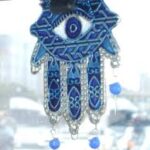
Hamsa Hand symbol
| Symbol | Hamsa Hand |
| Religion | Judaism, Islam |
| Origin | The Hamsa Hand symbol has origins in various cultures, including Middle Eastern, North African, and South Asian. |
| Meaning | It's often interpreted as a symbol of protection, good luck, and blessings. |
| Appearance | The Hamsa Hand typically features a hand with an eye in the center or within the palm. |
| Colors | Traditionally depicted in blue, but variations may feature other colors as well. |
| Usage | It's used as an amulet, jewelry, and decorative element. |
| History | The symbol has a long history, dating back centuries across different cultures. |
| Popularity | It has gained popularity globally, especially in jewelry and spiritual contexts. |
| Importance | It holds significance for those who believe in its protective and auspicious qualities. |
| Complexity | Its significance can be complex, as interpretations vary across cultures and individuals. |
| Emotions | It can evoke feelings of protection, positivity, and spirituality for those who embrace its symbolism. |
The Hamsa Hand: A Symbol of Protection Across Cultures
The Hamsa Hand, also known as the Hand of Fatima or Khamsa, is an ancient amulet symbolizing protection, good fortune, and blessings. Found throughout North Africa and the Middle East, it transcends individual religions and holds deep meaning for both Muslims and Jews.
Key points:
- Symbolism: Represents protection against evil eye, negative energies, and misfortune. Also signifies power,strength, and divine blessings.
- Origins: Dates back to ancient Mesopotamia, with different interpretations emerging in Judaism (Hand of Miriam) and Islam (Hand of Fatima).
- Design: An open right hand with five fingers (Hamsa means “five” in Arabic). Often depicted with an eye symbol for added protection.
- Variations: Orientation (upwards for general protection, downwards for fertility and abundance) and additional symbols (fish, Star of David) vary based on cultural context and personal beliefs.
- Significance: A widely recognized symbol worn as jewelry, displayed in homes, and incorporated into various art forms. Serves as a reminder of faith, cultural identity, and the desire for peace and well-being.
Remember: The Hamsa Hand is a powerful symbol with diverse interpretations. Respect its cultural significance and appreciate its enduring presence as a beacon of protection and good fortune.